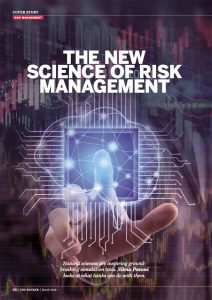Natural sciences are inspiring ground-breaking simulation tools, including companies like Simudyne.
Silvia Pavoni looks at what banks can do with them in this cover story in The Banker (an international financial affairs publication owned by The Financial Times).
Excerpt

From biology to the military to macroprudential activities, simulation – through agent-based models or otherwise – can find applications within commercial banks too. The software that Simudyne has built is based on Mitre’s intellectual property. The idea behind the partnership is that the more central banks and commercial banks will adopt those models, the safer global banking systems will be, to the benefit of the US too.
Traditional risk models had focused on the value at risk at individual institutions and then, with the introduction of stress testing by banking supervisors after the financial crisis, on taking a picture of how each bank would perform should a series of shocks be introduced in its environment. Those were static, primarily backward-looking methods. The idea now is to allow the risk function to consider how the interactions (rational or otherwise) within the system, connecting counterparties and taking into consideration human behaviours such as panic, could lead to instability and systemic collapses. By incorporating human behaviour into possible scenarios, agent-based models can help understand the impact of policy decisions on markets and the economy, according to Mitre.
And there are applications beyond risk management too, as agent-based modelling simulations can also be used in investment, such as in benchmarking exercises to discover best execution standards to help meet the more stringent requirements imposed by the second reiteration of Europe’s Markets in Financial Instruments Directive (better known as MiFID II).
Agents are simply representations of people, investors, banks or even central banks and these relationships can be calibrated to behaviours that can be observed, according to Mr Lyon, who says: “This means that the likelihood of individual funding counterparties to pull funds can be modelled directly – and the parameters governing this behaviour can be varied to explore a range of other outcomes.” These models can be used both to
evaluate the sensitivity of, say, a liquidity risk scenario to a number of alternative behavioural assumptions as well as to perform reverse stress testing, where risk managers can understand the way in which behaviour would have to change for a bank to get into trouble.
